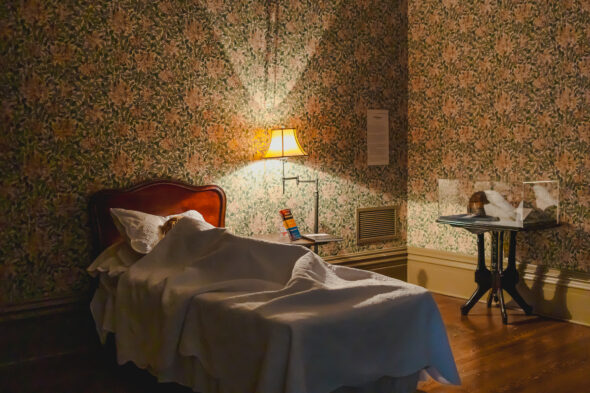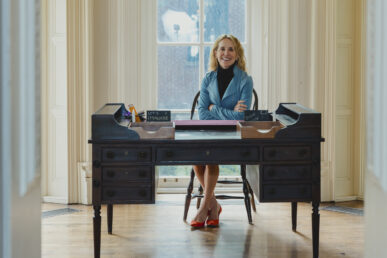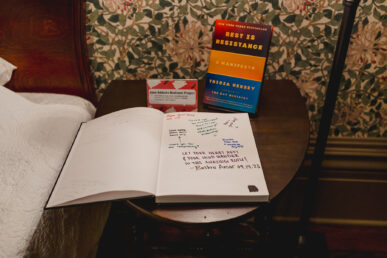Jane Addams Hull-House Museum offers chance to rest in an icon’s bed

On the second floor of the Jane Addams Hull-House Museum on the University of Illinois Chicago campus sits the bedroom where the legendary social reformer slept for many years.
Addams shared the room with her life partner, Mary Rozet Smith, whose large oil portrait still looks over the room as it did when the couple was alive. The room contains Addams’ journal and other artifacts, including a replica of the first Nobel Prize won by an American woman and Addams’ childhood bed.
Through the fall semester, UIC students, staff and faculty can absorb the tranquility felt in the honeysuckle-wallpapered room as part of the Jane Addams Bedroom Project. The initiative, designed to encourage resting and inspiration, offers anyone connected with UIC the opportunity to sign up and spend an hour alone in the room, either sleeping on the historic bed or just taking in the quiet.
Currently, spots are offered Tuesdays through Fridays from 3 p.m. to 4 p.m., but more times may be added due to the popularity. Anyone with a UIC email can sign up for free.
Jenna Farkas, a junior who transferred to UIC this fall, recently took advantage of the opportunity. She said that when she first walked into the activist’s former home last year, it was a “spiritual experience” for her, and she wanted to relive it.
“She’s a legend. She did a lot of great work and paved the way for great therapists and social work programs to continue,” said Farkas, a communication major. “It just seems like a very fitting time for it to be around. With midterms and school burnout, it would be nice just to relax in the room.”
After spending her hour alone behind the closed bedroom door, Farkas said she didn’t nap but rested on the bed. Afterward, she felt energized by the experience and was ready to tackle her schoolwork. She was amazed that the museum offered the opportunity.
“It’s hard to rest when you think, ‘Oh my gosh, there’s so much I can be doing,'” Farkas said. “But it’s important to rest.”
The project was conceived by Liesl Olson, director of the Jane Addams Hull-House Museum, after being inspired by the book, “Rest is Resistance: A Manifesto,” by Chicago-born author Tricia Hersey. Olson invited Hersey, a poet, activist and performance artist who currently lives in Atlanta, to kick off the project recently by reading from her book at Hull-House. She did so after donning pajamas and napping in the icon’s bed.
Olson said that Addams advocated rest for people and legislation to have a shorter workday.
“She recognized that in the neighborhood around Hull-House, people were working these 14-, 16-hour workdays of excruciating labor doing these repetitive, industrial tasks over and over again, and that was just inhumane,” Olson said. “You absolutely needed to legislate time for rest, time for play, time for the imagination and time for the arts.”
Olson said that rest is essential because technology has taken over our lives, and people seem to be working at all hours.
“Now, in our culture, there’s no time away from work. Work infiltrates all of our lives into the evening hours and early mornings and weekends via email, via Zoom,” Olson said. “There’s kind of a cultural assumption that we’re always going to be full on — we’re always going to be ready.”
Ross Jordan, curatorial manager for the museum, noted that with the project, the museum is stepping away from general rules of museum spaces that often prevent or limit interaction with exhibits.
“This project pushes back in two ways by allowing students (and others) to claim the room by themselves and have a real experience with the space, which is utterly unique to every visitor,” Jordan said. “It also says that we are a museum that allows people to actually enter and think through their own experiences with the history in an extended way, which is really fun.”
Olson called it an “anti-museum” project.
“You go to the Art Institute, and you see a chair — you can’t sit in it. Not even the curator can sit in it. So, this is kind of a pushback against that kind of museum space,” Olson said.
Several nappers who have written comments in a ledger on a nearby nightstand have let staff know how grateful they were for the opportunity to disconnect.
“Honestly haven’t taken this much time to myself to just rest and go through my thoughts. Thankful for this,” one person wrote. Another added, “Thank you for this awesome time to rest and recharge! W/out devices especially.”
Another person wrote, “Jane Addams is a legend. I strive to be as strong and passionate as she was. So much of modern day is due to her work. It felt so spiritual to sit alone in her room. I shed some tears — she paved the way for so many people’s rights and the field of social work. Perhaps it’s the stress, but I felt her in here encouraging us to finish what we started.”


